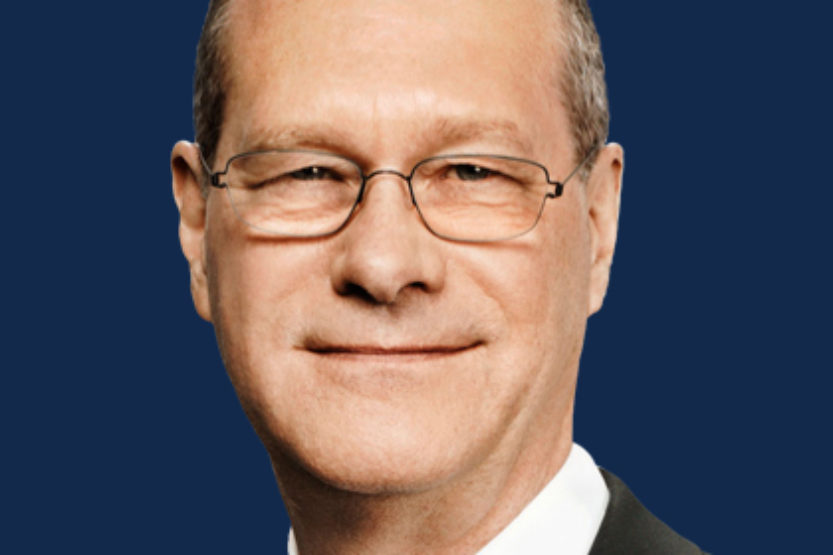2017 Alumni Award recipient, William Baker, MS ’80 ENG
 (Photo by Cody Pickens)
(Photo by Cody Pickens) Tower Builder
William Baker, MS ’80 ENG, and his family gathered by the Chicago River on a cold, windy January day in 2009 to peer up toward the gray heavens. A helicopter was ascending to the top of a very tall, very new building, lifting a long, narrow cylinder larger than the aircraft itself. It was the spire for the Trump International Hotel and Tower. A few minutes later, once the spire had been lowered into place and attached, the building officially joined an exclusive club. Measuring 1,389 feet, the Trump Tower was now among the world’s 10 tallest structures.
As the project’s chief structural engineer, Baker could have counted the setting of the spire as a career-defining moment of triumph. But the Trump Tower was just one of several global landmarks he was overseeing at the time. And it wasn’t even the loftiest. That distinction goes to the 2,717-foot Burj Khalifa in the United Arab Emirates city of Dubai, which is still the single tallest structure ever erected. Also in Baker’s portfolio are the Zifeng Tower in Nanjing, China (1,476 feet), the Pearl River Tower in Guangzhou, China (1,015 feet) and the Cayan Tower in Dubai (1,005 feet).
When your active-projects list includes 5 percent of the world’s tallest buildings, it’s safe to say you’ve scaled some pretty impressive professional heights. Baker’s success stems from a lifelong commitment to continual innovation, as well as a design philosophy that translates well to super-tall, glass-and-steel buildings. Such skyscrapers are the hallmark of Skidmore, Owings & Merrill, the Chicago firm where Baker is a partner.
He explains his approach: “I believe in simplicity and clarity, along with the importance of order and hierarchy. It’s critical to identify the most important elements of your structure and to give those the right of way when conflicts arise.
“I believe in elegance, and I also believe something has to be rational and economical.”
A lot to learn
Baker arrived at UI in 1978. His résumé included two years in Texas and Oklahoma, working for petroleum giant Exxon. His work in the oil fields convinced him he had a lot to learn. “It was just enough for me to become aware that there was a lot I didn’t know,” Baker recalls.
He quickly set about expanding his knowledge and expertise. After earning a Master’s in civil engineering in 1980, he stayed an extra year at Illinois to tackle additional courses on such intimidating subjects as “Non-Linear Theory of Elasticity” and “Behavior of Concrete.”
“If you’re going to do something new, then by definition you can’t look it up in a book. You have to go back to the physics of the problem,” Baker says. “It’s not about just reading a building code and doing what someone else has done before. It’s understanding how all the materials behave and how structures react to different forces.”
In 1981, Baker took a job at SOM. The legendary architectural and engineering firm had recently cemented its global, 45-year legacy by constructing two skyscrapers in Chicago, the John Hancock Center and the Sears (now Willis) Tower. Baker had already served an internship at the firm, thanks to its strong connections with the UI engineering faculty.
“Almost all of the leading engineers at SOM in Chicago had studied at Illinois—that was definitely part of the culture,” Baker recalls.
Buttressing the Burj
Baker’s creative, fundamentally sound approach has proved particularly successful when applied to skyscrapers. Shortly after SOM won the contract for Burj Khalifa, Baker discovered that his initial structural design wouldn’t be sufficient to sustain local wind forces. That meant he was on the hook to create a new one to support the building. Consequently, he designed a system called the “buttressed core,” which uses the strength of three protruding residential wings to support the building’s central, hexagonal tower. The result: a mammoth tower that is “very quiet in the wind,” Baker says.
That achievement garnered him the Fritz Leonhardt Prize for achievement in structural engineering, which Baker received in 2009, the first American so honored.
For Baker, his engineering achievements all come back to the fundamentals that he learned so well at Illinois.
“It’s only once you know how all the materials and forces work, along with a bit of the history of engineering and what has been done before, that you’re able to synthesize something new,” he concludes.

